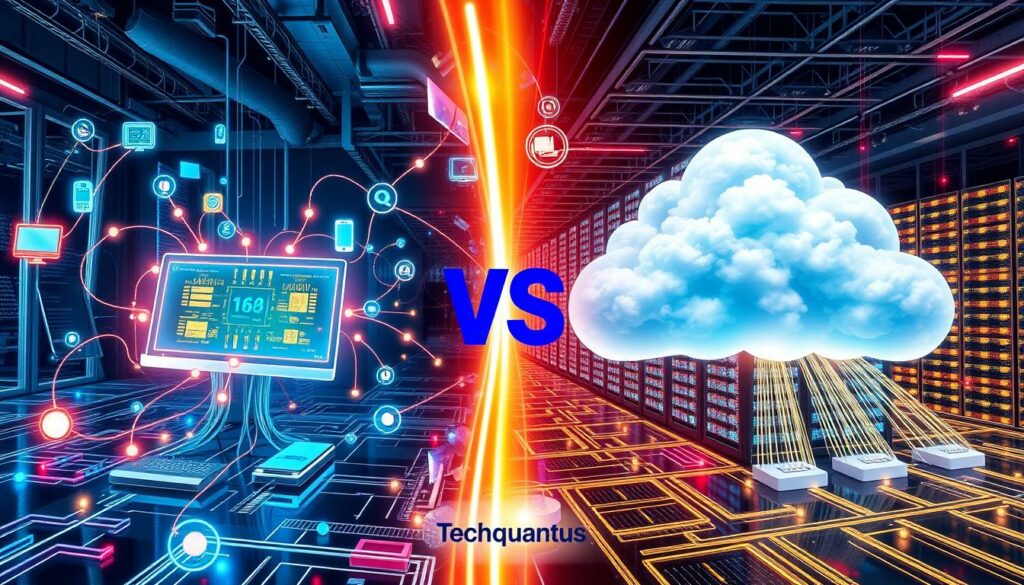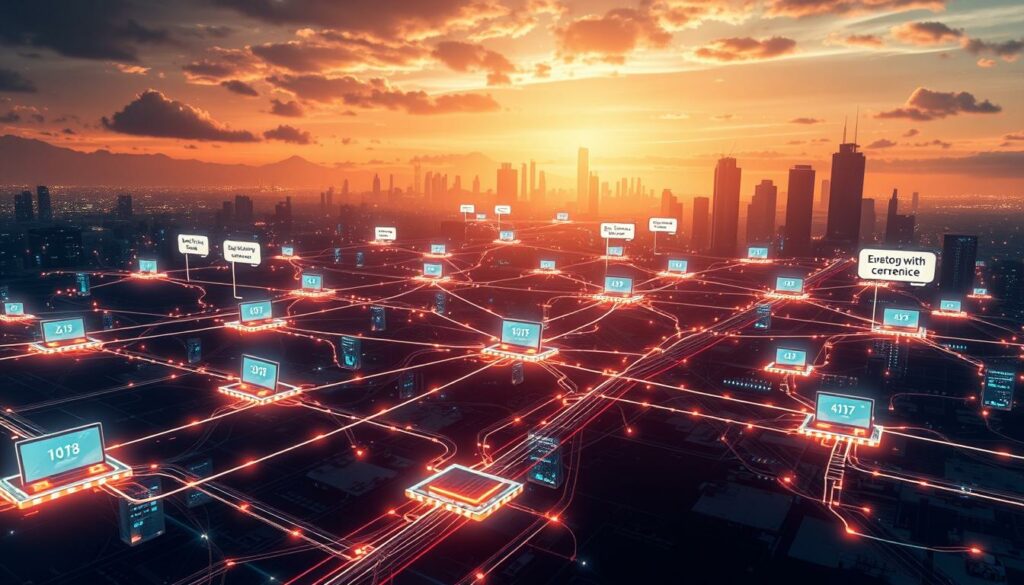Did you know the global eClinical solutions market is set to hit USD 22.1 billion by 2029? This growth is huge, with a 13.7% annual increase expected. It’s all because companies want to make decisions faster. With more IoT devices creating lots of data, Edge Computing is key for handling this data efficiently.
Edge Computing moves data processing closer to where it’s created. This means faster processing and quicker decisions. It’s a big change in how we handle data, making it crucial for the future of IT. Knowing about Edge Computing helps your business stay ahead and work more efficiently.
Key Takeaways
- Edge Computing boosts data processing by cutting down on delays.
- The eClinical solutions market is growing fast, thanks to the need for quick data analysis.
- Processing data closer to where it’s made helps with better decision-making.
- Understanding Edge Computing is key for staying ahead in the changing IT world.
- Using Edge Computing gets businesses ready for future data processing needs.
Introduction to Edge Computing
Edge computing is changing how we handle data, especially with data creation soaring. It lets you process data right where it’s made, not just in big data centers. This approach cuts down on delays and boosts speed for apps needing fast data handling.
The key idea of Introduction to Edge Computing is solving old data processing problems. With more IoT devices and connections, quick data analysis is vital for better user experiences and system efficiency. Processing data locally means faster responses and better system performance.
Edge computing also makes it easier to use complex analytics at the edge for quick insights. This is key for making fast decisions. As edge computing grows, companies using it will find new chances for growth and innovation.
Understanding Data Processing Needs
Data is key to making smart Decision Making in many fields. Companies use Data Analysis to find important insights. This helps shape their strategies and improve how they work. Knowing how to handle Data Processing Needs is crucial for staying ahead in today’s data-focused world.
The Role of Data in Decision Making
Data is now a big part of making decisions. Companies use tools to handle lots of data. This helps them understand market trends and what customers want. Having good data and efficient ways to process it is vital. Without it, companies might not do well or keep up with market changes.
Challenges in Traditional Data Processing Methods
Many companies face Traditional Data Processing Challenges. These problems often include:
- Latency Issues, which slow down getting to important data.
- High costs for sending and storing data.
- Difficulty with real-time analytics, making quick business responses hard.
These issues call for new solutions like edge computing. It can make data processing faster and overcome traditional method problems.
Key Benefits of Edge Computing
In today’s digital world, businesses look for quick and efficient solutions. Edge computing is a game-changer that boosts productivity in many areas. It offers big perks like cutting down on delays and making things faster.
Improved Latency and Speed
Edge Computing is great for reducing latency. It does this by processing data near where it’s created. This is key for fast action in areas like self-driving cars and online games. It makes things run smoother and gives users a better experience.
Enhanced Data Privacy and Security
Edge Computing also means better security. By handling data locally, less sensitive info goes to big data centers. This lowers the risk of data theft. It also helps follow strict privacy rules and keeps users trusting the system. With strong security, access to private data is closely watched and controlled.
Cost Efficiency in Data Management
Edge Computing is also a smart choice for saving money. It cuts down on the need to move data, which means less bandwidth costs. This is especially good for companies dealing with a lot of data. Investing in Edge Solutions helps with managing data better and boosts innovation.
For more on how to make platforms better for developers, check out this resource.
| Benefit | Description | Impact |
|---|---|---|
| Latency Reduction | Process data closer to the source for faster response times | Improved user experience and quicker insights |
| Data Privacy | Minimizes data transfer to central servers, enhancing security | Higher compliance and trust from users |
| Cost Efficiency | Reduces bandwidth costs by processing at the edge | Substantial savings for high-data volume companies |
Edge Computing vs. Cloud Computing
It’s key to know the differences between edge computing and cloud computing to make smart choices. Each has its own strengths, thanks to its Architecture Models. With the right info, you can pick the best Business Solutions for your needs. This helps in understanding the Edge vs Cloud Decision.
Comparing Architecture Models
Edge computing works by processing data near where it’s made. This means faster speed and lower latency. Cloud computing, on the other hand, sends data to remote centers for processing. Here’s how they stack up:
| Feature | Edge Computing | Cloud Computing |
|---|---|---|
| Data Processing Location | Near the data source | Remote data centers |
| Latency | Low latency | Higher latency |
| Cost Efficiency | May reduce data transmission costs | Depends on data volume |
| Data Security | Localized security measures | Centralized security protocols |
Choosing the Right Solution for Your Business
When deciding between Edge vs Cloud, think about your business goals, budget, and what you need for performance. Here are some things to keep in mind:
- Check if speed matters: If you need to process data fast, edge computing might be the better choice.
- Look at costs: Decide if processing data locally saves money compared to sending it to the cloud.
- Think about security: See how each option meets your data privacy rules.
- Consider growth: Think about how each solution can grow with your business.

Real-World Applications of Edge Computing
Edge computing is changing many industries in big ways. It makes things work better, handles data better, and makes operations more effective. By processing data near where it’s created, companies can use edge computing’s benefits in many areas.
Use Cases in Healthcare and Pharmaceuticals
In healthcare, edge computing helps with things like real-time health checks and managing patient data. With tools like electronic data capture (EDC), doctors can quickly access and analyze important data. This is key to better patient care. The eClinical solutions market is expected to hit USD 22.1 billion by 2029, showing how crucial smart data handling is in healthcare.
Benefits for Smart Cities and IoT Devices
Smart cities use edge computing to make connected devices work better. It lets them process data in real-time, which helps with traffic, energy use, and safety. As cities get smarter, they invest more in IoT, setting the stage for better urban growth. This leads to a better life for city folks.
Applications in Manufacturing and Logistics
In manufacturing, edge computing helps keep an eye on machines in real-time, boosting efficiency. For logistics, it makes managing inventory and streamlining supply chains better. Analyzing data at the edge improves speed and cuts costs. As manufacturing takes up these techs, the market is growing fast, showing edge computing’s big impact on how things work.
Challenges and Considerations for Implementation
Edge computing brings big benefits but also has its challenges. It’s key for any company to tackle these challenges to make the most of this new tech. Understanding the complexities, like Technical Barriers and Regulatory Compliance, is vital for success.
Overcoming Technical Barriers
Companies often run into Technical Barriers when adding edge computing to their systems. Some common hurdles include:
- Integration issues with old systems that may not work well with edge computing.
- Scalability talks—making sure the setup can grow as data grows.
- Network reliability issues, needing high uptime and low latency for edge setups.
A strategic plan can help overcome these problems. Having a clear idea of what you want from your edge computing setup guides better decisions. This leads to smoother integration, scalability, and reliable networks.
Regulatory Compliance and Edge Computing
Edge computing brings its own set of rules that companies must follow. They need to keep up with laws like GDPR or CCPA, which control how data is handled and processed. These laws can affect how you process data at the edge.
Important things to think about include:
- Staying informed about laws that could affect edge computing.
- Ensuring data protection steps are strong enough to meet laws while keeping performance up.
- Fostering an environment for new ideas without breaking compliance rules.

By planning ahead for compliance with edge computing, companies can manage risks better. This way, they stay on the right side of the law and keep up with tech progress.
Future Trends in Edge Computing
The world of edge computing is changing fast, with big changes coming up. Edge Computing Trends are adapting to new tech needs. Artificial intelligence and machine learning are becoming key at the edge. They help process data in real-time, making things work better and faster for important tasks.
Businesses see the big benefits of using AI closer to where data is. This cuts down on internet use and speeds up responses. It’s a big win for many industries.
New edge devices are also changing the game. They’re made for different places, like work and homes. These devices help capture and process data better. This leads to smarter decisions in fields like healthcare and cars.
Security is a big concern in edge computing. With data moving around, there’s a higher chance of it getting hacked. So, new security tech is coming to the edge. Companies are working on strong security steps and encryption to keep data safe.
Edge computing is making a big impact on the chip market. Chip sales went over $500 billion in 2023. Now, there’s a big need for safe ways to ship chips. A new market for shipping boxes is helping with this. Over 1,000 chip places use these boxes, showing how edge tech and chips are connected. For more info on this, check out this article.
Edge Computing: The Future of Data Processing
The edge computing world is changing fast, showing big growth and new ideas. More people want data processed quickly and efficiently. This means the Edge Computing Market Growth will likely grow a lot in the next few years.
Predicted Growth of Edge Computing Market
Experts say the eClinical solutions market will grow a lot. They think the Edge Computing Market Growth will go up by 13.7% each year. By 2029, it could be worth about USD 22.1 billion. This shows we need faster and better ways to handle data.
Technological Innovations Driving Adoption
New tech is key to making edge computing more popular. Better connections mean data moves faster, and smarter analytics make edge processing quicker. With 5G technology, we can support more devices that need quick data access. This change is making a big difference in how industries use data.
| Year | Market Value (USD) | CAGR (%) | Key Drivers |
|---|---|---|---|
| 2024 | $11.6 Billion | 13.7% | Data Integrity, Regulatory Compliance |
| 2029 | $22.1 Billion | 13.7% | Increasing demand for eClinical solutions |
With edge computing growing and new tech coming out, the future of data processing looks bright. Companies are looking for ways to use edge technology to their advantage.
Conclusion
Edge computing is key to meeting today’s and tomorrow’s data needs. It’s vital for making businesses faster, more agile, and secure. By cutting down on delays and boosting efficiency, edge computing is set to revolutionize many industries.
Understanding the future of data processing is crucial in today’s tech world. The article has shown how edge computing is at the forefront of this change. It prepares you for now and the future tech changes.
With threats like the PEAKLIGHT dropper on the rise, investing in edge solutions is a smart move. It helps protect against cyber threats. Edge computing is essential for a secure and efficient IT setup, making it a smart choice for the future.
FAQ
What is edge computing?
Edge computing is a way to process data where it’s created, close to the source. This cuts down on delay and makes real-time analysis possible. It’s key for handling the huge amounts of data from IoT devices quickly and efficiently.
How does edge computing reduce latency?
Edge computing cuts down on the time it takes for data to reach central locations by processing it closer to where it’s made. This is crucial for fast action in things like self-driving cars and online games, where quick decisions are a must.
What are the security benefits of edge computing?
Edge computing boosts security by handling sensitive info right where it’s needed, not sending it to far-off data centers. This lowers the risk of data theft and helps meet privacy laws by sending less data over networks.
How can edge computing lead to cost savings for businesses?
Companies save money with edge computing by sending less data to and from central spots, which cuts down on bandwidth costs. This is especially good for firms dealing with a lot of data.
What distinguishes edge computing from cloud computing?
Edge computing focuses on processing data locally, unlike cloud computing’s centralized approach. Both have their pros and cons, so picking the right one depends on your specific needs.
What industries can benefit from edge computing?
Many industries see big benefits from edge computing, like healthcare for real-time health checks, smart cities for better traffic flow, and manufacturing for smoother supply chains.
What challenges are there in implementing edge computing?
Putting edge computing into action can face hurdles like fitting with current systems, scaling up, and keeping networks stable. It’s important for companies to tackle these issues for success.
How does regulatory compliance affect edge computing implementations?
Companies need to follow rules on data protection and privacy when using edge computing. Making sure you’re in line with the law is key to staying innovative while keeping sensitive info safe.
What future trends are emerging in edge computing?
Edge computing is seeing new trends like combining AI and machine learning at the edge, better edge devices, and stronger security. These changes will keep shaping how we handle data.
What is the projected growth of the edge computing market?
The edge computing market is set to grow a lot, with a 13.7% annual growth rate. This will take the market to about USD 22.1 billion by 2029.
Source Links
- eClinical Solutions Market to Cross $22.1 Billion by 2029: Analysis of Market Trends, the Ecosystem, Case Studies, Regulatory Landscape, Patents, Technologies, Pricing, and the Competitive Landscape
- Ubiquitous Computing Market to Reach $3.6 Billion, Globally, by 2032 at 19.4% CAGR: Allied Market Research
- Build Platform Engineering as a Product for Dev Adoption
- Manage Multiple Jupyter Instances in the Same Cluster Safely
- Top 10 Latest Trends in AI Development For 2024
- Data Center Liquid Cooling Global Business Report 2024-2030 – Integration of IoT in Data Centers Sets the Stage for Innovative Liquid Cooling Solutions
- Q&A with Addison HVAC Product Director Peter Fung
- Procesarea şi stocarea de date se mută în edge – ClubIT&C
- Fortinet aprimora proteção com nova solução SASE unificada e abrangente – Inforchannel
- Global Front Open Shipping Box Market To Attain Valuation of US$ 497.1 Million by 2032 | Astute Analytica
- Hyper Converged Infrastructure Market is valued at approximately $16.2 Billion in 2023 and is anticipated to grow with a CAGR of more than 28.6% By 2032
- Single Board Computer Market Set to Worth Over USD 7,486.1 Million By 2032 | Astute Analytica
- PEAKLIGHT Dropper: Hackers Target Windows With Downloads
- Ketryx tackles software safety in medical devices amid growing recalls
- My Guide to Understanding Data Centre Architecture: Core Components Every IT Pro Should Know
- Wazuh Home Network Setup: A Step-by-Step Guide
- Quantum Computers Decrypting Blockchain: The Risks and Implications
- Wazuh: Enterprise-Grade Security for Your Business
- Wazuh for Beginners: A Comprehensive Guide




